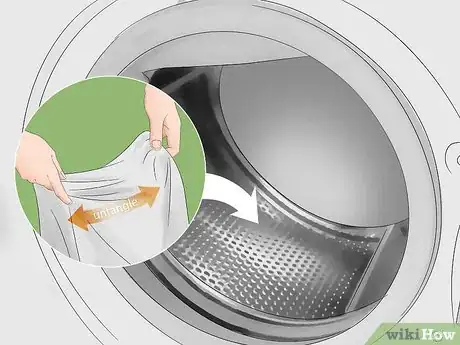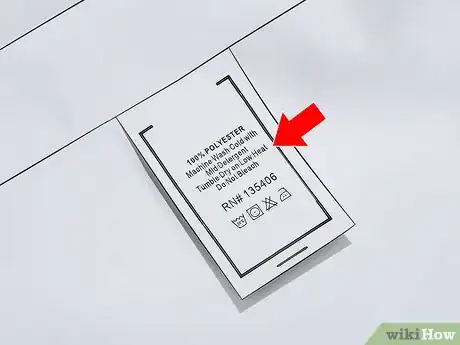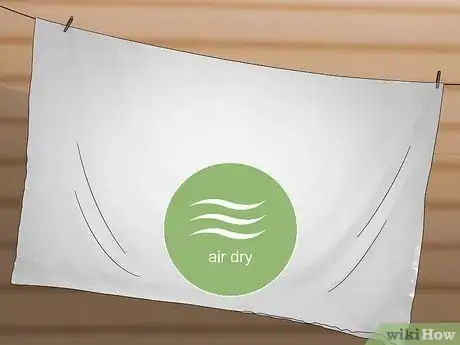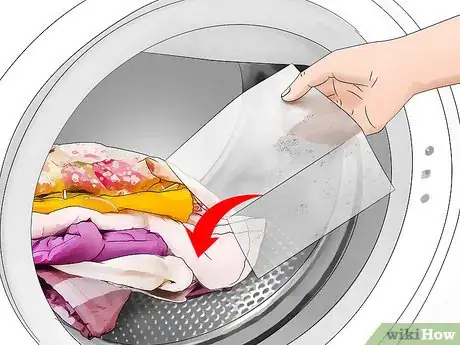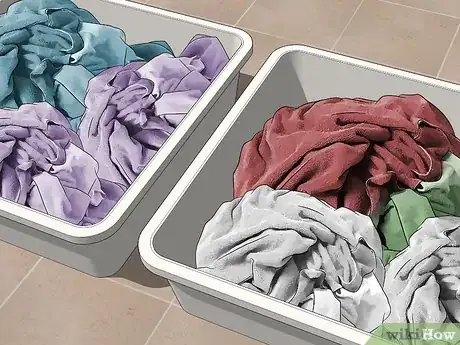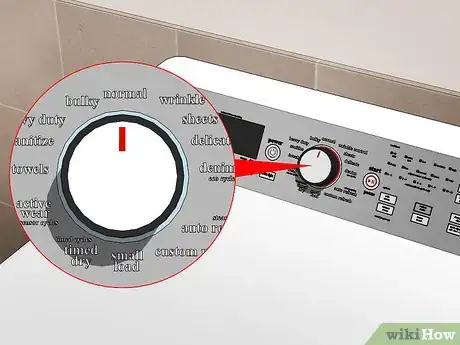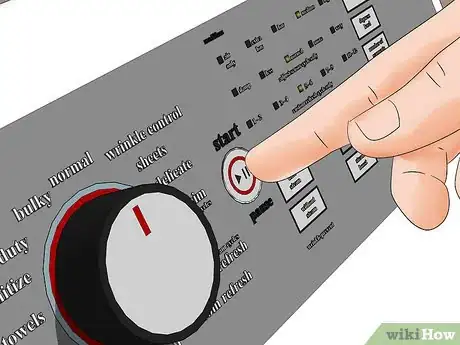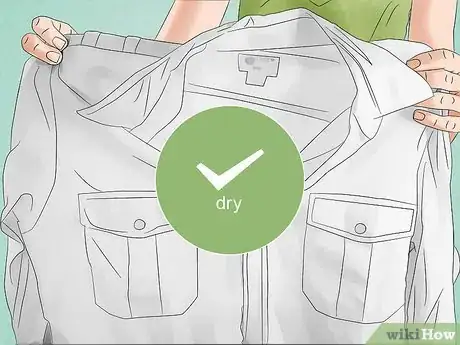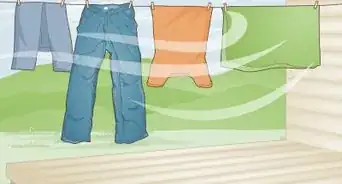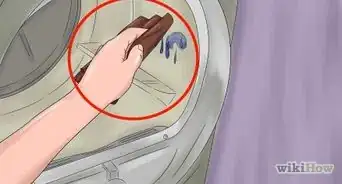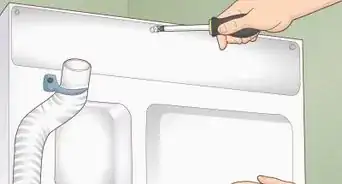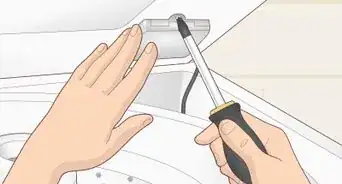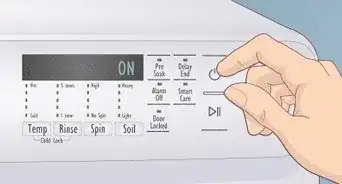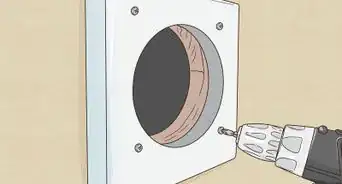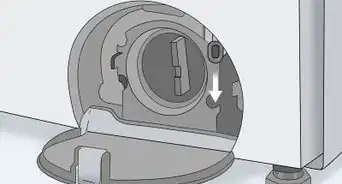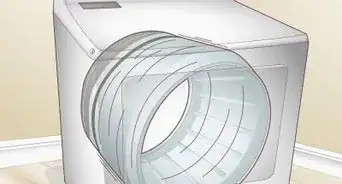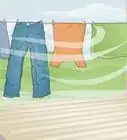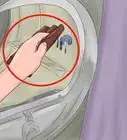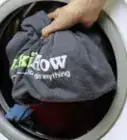This article was co-authored by Safir Ali. Safir Ali is the Co-Founder and CEO of Hamper Dry Cleaning and Laundry, a startup in Houston, Texas reinventing the laundry industry. With over six years of experience launching and operating Hamper, Safir specializes in innovative ways to simplify dry cleaning using the experience from his family's business. Safir holds a Bachelor’s degree in Business Administration and Management from Texas A&M University. Hamper offers 24/7 on-demand dry cleaning and laundry through delivery and kiosk services. Hamper has been featured on the Houston Rockets, Station Houston, the Houston Business Journal, BBVA, Yahoo Finance, and Innovation Map.
There are 16 references cited in this article, which can be found at the bottom of the page.
This article has been viewed 84,338 times.
Clothes dryers are convenient household appliances, but if used incorrectly, you can easily waste electricity and gas, or possibly damage your clothes and linens. If you are just learning how to use a dryer and aren’t sure where to begin, don’t worry. With a little preparation, you can learn to identify what clothes are suitable for machine drying and what clothes should air-dry. Once you determine the items you need to dry, you will be able to properly set the heat levels and timer.
Steps
Loading the Dryer
-
1Untangle your wet clothes and linens before putting them inside of the dryer. The spin cycle on the washing machine is used to remove excess water from the articles of clothing and linens. However, it also can compress and tangle the items. Before loading up the dryer, take a few moments to untangle and shake out the items. Items that are tangled in the dryer may not dry completely or at all.[1]
- Lengthy items like sheets or large beach towels can get particularly tangled in the washing machine. Make sure that the items are separated and not twisted.
-
2Check the drying care instructions on the inside label of each clothing item. This will help you avoid shrinking, melting, or damaging fabrics that are not meant to dry under intense heat. Most clothing items, and even household fabrics like curtains, will have a tag sew onto them giving recommended washing and drying instructions. Some items will recommend tumble drying an item with low heat, and others may specifically say to not tumble dry.[2]
- Most tags can be found on the inside seam along the back of the neckline of shirts or waistline of pants and shorts. Some dresses and other more formal items may have the tag sewn along one of the inside seams on the sides of the item.
- Take items that need to be dry cleaned to the dry cleaners. Attempting to wash or dry items that are dry-clean-only at home may permanently damage the material.
Advertisement -
3Let delicate clothing items air-dry to avoid damaging them. Delicate fabrics can be damaged over time if they rub against buttons or rough material like denim in the dryer. To extend the life of delicate garments, make some room in a closet to hang clothes to air-dry, or invest in a drying rack.[3]
- Drying racks are great to lay out sweaters on during the winter months, and can be easily folded up and stored away when you are not using them. Local department stores near you should carry a variety of drying racks that will hold 1 or multiple garments.[4]
- Delicate garments like bras, sweaters that might easily obtain pulls or become matted, and clothing made of silky or lace fabrics, should not be put in the dryer. The constant tumbling motion will degrade and damage the fabrics.[5]
- Be careful with clothing items that are 100 percent cotton as they will shrink during the first few times you put them in the dryer. Even items that are partly cotton may have some shrinkage over time. Any cotton items you don’t want to shrink should be hung or laid out to dry as well.[6]
- If you need to use the dryer for delicate garments, use the no heat or low heat option (if available).
-
4Store delicate items in mesh bags before putting them in the dryer. Mesh bags are inexpensive and good to have handy for those days when you have enough delicate items to warrant a separate load of laundry, or for when you don’t want to air-dry the items. The mesh bags will help keep them from getting tangled or damaged while tumbling in the dryer.[7]
- You can purchase mesh bags at local department stores, or online with major retailers.
- Always put your bras into mesh bags before putting them in the washing or drying machine. This will keep the lengthy straps from getting knotted with other clothing, and will prevent the clasps from hooking onto or putting pulls in other fabrics.
- Just make sure not to overstuff the mesh bags. Have a couple on hand so you can separate out the load of delicate items as much as possible, and limit yourself to only put 1 large item or 4 small items in each bag.
-
5Reduce static cling by placing a dryer sheet into the dryer with the wet clothes. The dry air inside of the rotating metal drum causes static to build up between the fabrics as they rub together. Dryer sheets will also soften rough fabrics, so keep a box of them next to or on top of your dryer so you don’t forget to use one. When the load of laundry is done, just throw away the sheet as the effects are only good for 1 use.[8]
- Dryer sheets are available in a variety of scents to match or compliment the soap you used to wash your clothes. If you are sensitive to flowery smells, there are even ones that are unscented.
- Static cling is more prevalent during the winter or on dry days when there is not a lot of humidity in the air. Make sure to use dryer sheets throughout the winter.[9]
- If you used fabric softener while washing your clothes, then it is not necessary to use a dryer sheet as both remove static and soften the fabric.
-
6Split up large amounts of wet clothes or linens into multiple drying loads. The dryer needs space on the inside to tumble the clothing. Splitting up large loads will help the items aerate properly. If you overload your dryer, not only will the items still be damp, but overloading can also damage the tumbling mechanism within the dryer over time.[10]
- Dry large loads of towels, sheets, and blankets separately. When wet, these items are heavy and will not be able to tumble properly if stuffed into the dryer at once.
Using the Dryer Settings
-
1Select a drying temperature for the type and amount of wet laundry you have. It is important to pick the right heat setting to ensure that your clothing dries in an effective amount of time. Standard drying temperatures may be labeled: Regular, Medium, Low, or Air Fluff. The wording for this, however, can vary slightly between brands and styles of dryers.[11]
- The heat setting is usually a knob that you can rotate clockwise or counter-clockwise to select an option. The pointer on the dial needs to line up with the indicated notch for a particular setting.[12]
- Use the regular heat temperature for everyday clothing and cotton items like towels and sheets. The medium setting will emit slightly less heat than the regular setting. This temperature is also good for a medium load of casual or everyday clothing items, but not for thick or plush cotton-like towels.[13]
- Use the low setting for drying delicate items like bras, curtains, or tablecloths.[14]
- If you dried a load of laundry and forgot it was in the dryer for a day or two, the items may be wrinkled or creased. Use the air fluff setting to inject life back into the items, and remove any creases before you take the items out and fold them.[15]
-
2Set the drying time based on the type and amount of items in the dryer. The timing dial on a dryer will most likely be broken up into categories similar to the heat setting. It may have separate sections labeled cottons, casuals, and delicates, so you can match the tumbling time with the temperature. Within each section, there will be a grade of specific timing options like more, optimum, or less drying that will limit the drying time for different load sizes.[16]
- The timer is usually represented by a knob with a pointer that will click as you turn it clockwise to match a desired setting.[17]
- If you set the temperature to regular because you have a medium load of everyday clothing items, then set the timer to the section labeled cottons and optimum drying. For large loads, set the dial to cottons and more drying, and for smaller loads, set the dial to cottons and less drying.[18]
- If you set the temperature to a low heat because you have a medium load of delicate items, then set the timer to the section labeled delicates and optimum drying. Change the timing between more or less drying if the load of delicates is large or small.[19]
-
3Set the drying minutes if there are no categorical timing options. Not every dryer will have a specific time setting dedicated to different types of clothing, and some dryers may even offer both options. This setting will look like a dial with increments of 10 minutes around it. Using the numerical timer requires less thought because the time is not usually printed with the categorical options. Simply turn the dial clockwise until the point on the dial matches the desired drying time.[20]
- Most small or medium loads that are damp will be dry within 20 or 30 minutes. Larger or heavier laundry loads can take anywhere from 40 to 60 minutes to be completely dry.
-
4Use the extended tumble cycle to keep the clothes from wrinkling when dry. Some dryers will have a separate setting to turn on and off an extended tumbling cycle. This setting will continue to tumble the clothing and keep it moving beyond the set timer and without any heat. Turn this setting on if you don’t want the laundry to wrinkle, and plan on folding it within a short time of it being done drying.[21]
-
5Turn the signal sound dial on or off to alert you when the drying cycle is done. Some dryers can emit a medium or loud buzzing sound to signal you that your laundry is done drying. Turn the signal on if you don’t want your laundry to rest and wrinkle in the dryer.[22]
-
6Press the start button when you are happy with your settings. Modern dryer models will most likely have a small start button separate from the dials. Once you have loaded and properly set the heat and timer, close the door to the dryer and press start.[23]
- Not every dryer will have a specific button dedicated to starting the machine. Older models may require you to press in the timer dial to start the machine. Refer to the user manual that came with your dryer if you are unsure where the start option is located on your particular model.
-
7Check that the load of laundry is completely dry when the machine turns off. If you selected a specific time, or if you had too many clothes in the dryer for a particular heat setting, some of the items may not be dry once the cycle is done. Check some of the larger items for dampness or wet spots. If those items feel dry, generally the rest of the load will be too. If the items feel damp, put the items back into the machine and set the timer for another 10 to 20 minutes.[24]
- Some items, like sheets, may become tangled or balled up while drying. This can cause portions of the sheets to not dry properly. If this happens, untangle the sheets and place them back in the dryer. Set the dryer to run on a medium heat for 10 to 15 more minutes.[25]
-
8Empty the lint trap when your load of laundry is completely dry. The lint trap looks like a long vent, and is usually located inside the bottom lip of the dryer opening. It is very important to empty the lint trap between drying loads of laundry. An excess buildup of lint can eventually damage the machine, and even pose as a fire hazard if neglected long enough.[26]
- To empty most lint traps, you simply lift the small handle on the lint screen until the entire piece is removed. Then glide your fingers over the rigid netting on the lint screen, and remove any fibers or hairs that have built up on it. The lint will naturally want to stick to itself, so use the lint to aid the cleaning process.[27]
- Once the netting is clean, slide the lint screen back into place so you are ready to dry your next load of laundry.[28]
Warnings
- Make sure to empty the lint trap between drying loads of laundry. The accumulation of lint within a dryer can damage your dryer over time, and become a serious fire hazard.[30]⧼thumbs_response⧽
- If you share a dryer with other people, make sure to check the lint trap before you put your wet clothes in the dryer. Not everyone will remember to empty the lint trap when they are done using the dryer, and this can quickly cause lint accumulation.[31]⧼thumbs_response⧽
- Never dry anything that has ever had any type of oil on it, since no washing machine can completely remove them and it can start a fire.⧼thumbs_response⧽
References
- ↑ https://www.dummies.com/home-garden/how-to-dry-clothes-in-a-clothes-dryer/
- ↑ https://www.omo.com/za/laundry/laundry-tips/washing-machine-guide/the-pros-and-cons-of-have-a-drying-machine.html
- ↑ https://www.omo.com/za/laundry/laundry-tips/washing-machine-guide/the-pros-and-cons-of-have-a-drying-machine.html
- ↑ https://www.omo.com/za/laundry/laundry-tips/washing-machine-guide/the-pros-and-cons-of-have-a-drying-machine.html
- ↑ https://www.realsimple.com/home-organizing/cleaning/laundry/how-do-laundry
- ↑ https://www.zmescience.com/other/feature-post/dryer-shrinks-clothes/
- ↑ https://www.cosmopolitan.com/lifestyle/how-to/a44293/how-to-wash-bras/
- ↑ https://wonderopolis.org/wonder/how-do-dryer-sheets-prevent-static-cling
- ↑ https://www.sciencebuddies.org/blog/the-shock-of-static-electricity
- ↑ http://www.safebee.com/home/dryer-fire-tempted-dry-clothes-without-cleaning-lint-filter
- ↑ https://www.dummies.com/home-garden/how-to-dry-clothes-in-a-clothes-dryer/
- ↑ https://www.insideedison.com/stories/understanding-different-washer-dryer-settings
- ↑ https://www.dummies.com/home-garden/how-to-dry-clothes-in-a-clothes-dryer/
- ↑ https://www.dummies.com/home-garden/how-to-dry-clothes-in-a-clothes-dryer/
- ↑ https://www.insideedison.com/stories/understanding-different-washer-dryer-settings
- ↑ https://www.goodhousekeeping.com/appliances/dryer-reviews/a18967/dryer-glossary/
- ↑ https://www.goodhousekeeping.com/appliances/dryer-reviews/a18967/dryer-glossary/
- ↑ https://www.realsimple.com/home-organizing/cleaning/laundry/washer-dryer?slide=13122#13122
- ↑ https://www.realsimple.com/home-organizing/cleaning/laundry/washer-dryer?slide=13122#13122
- ↑ https://greenlivingideas.com/2014/12/05/use-your-washer-and-dryer-efficiently/
- ↑ https://www.goodhousekeeping.com/appliances/dryer-reviews/a18967/dryer-glossary/
- ↑ http://lifestyle.euronics.co.uk/buyers-guide/tumble-dryers/features/
- ↑ https://www.cleanipedia.com/au/laundry-washing/how-to-use-a-tumble-dryer
- ↑ https://greenlivingideas.com/2014/12/05/use-your-washer-and-dryer-efficiently/
- ↑ https://www.persil.com/uk/laundry/laundry-tips/washing-tips/how-to-use-a-tumble-dryer-to-dry-clothes.html
- ↑ http://www.safebee.com/home/dryer-fire-tempted-dry-clothes-without-cleaning-lint-filter
- ↑ https://greenlivingideas.com/2014/08/14/clean-dryers-lint-trap-duct-screen/
- ↑ https://greenlivingideas.com/2014/08/14/clean-dryers-lint-trap-duct-screen/
- ↑ https://www.omo.com/za/laundry/laundry-tips/washing-machine-guide/the-pros-and-cons-of-have-a-drying-machine.html
- ↑ http://www.safebee.com/home/dryer-fire-tempted-dry-clothes-without-cleaning-lint-filter
- ↑ http://www.safebee.com/home/dryer-fire-tempted-dry-clothes-without-cleaning-lint-filter
